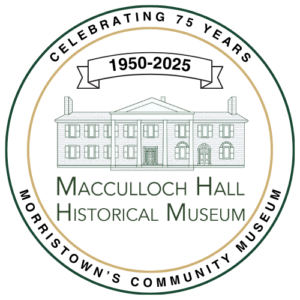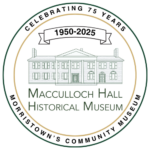At the Museum
- Available Tuesday thru Friday
- 90 minutes to 2 hours in length, depending upon age of students
In your classroom
- Available Tuesday thru Friday
- 45 minutes or length of class period
To schedule school programs please fill out our inquiry form by clicking the button below.
School Programs We Currently Offer
A Home Away From Home
1st grade
- At Macculloch Hall Historical Museum only
- 90 minute program
- Visit the kitchen and drawing room at Macculloch Hall
- Tour the restored garden
- Learn what Mr. Macculloch grew on his farm
- Make a decorated cardboard grandfather clock
- Hear about family traditions from Great Britain and the American holidays celebrated by the Macculloch family.
Meets the following New Jersey Student Learning Standards:
6.1.2.GeoHE.1, 6.1.2.GeoHE.2, 6.1.2.GeoHE.4, 6.1.2.GeoGI.1, 6.1.2.HistoryCC.1, 6.1.2.HistoryCC.3, 6.1.2.HistorySE.3
Lessons from the Garden
2nd-3rd grade
- At Macculloch Hall Historical Museum only
- 2 hour program
- Visit the restored historic garden
- Discuss the plant cycle, including plant parts and their purposes
- Learn about repurposing and recycling in the 19th century
- Examine soil types while preparing soil for planting bean seeds to take home
- Learn about vermicomposting and handle earthworms to understand their purpose in creating rich soil
- Participate in a garden scavenger hunt
- Program runs rain or shine
Meets the following New Jersey Student Learning Standards:
6.1.2.GeoPP.1, 6.1.2.GeoHE.1, 6.1.2.GeoHE.2, 6.1.2.GeoGI.1, 6.1.2.EconET.2, 6.1.2.EconEM.3, 6.1.2.HistoryCC.3, 6.1.5.GeoPP.2, 6.1.5.EconET.3, 6.1.5.EconEM.5, 6.1.5.HistoryCC.9
Meeting Mr. Macculloch
2nd-4th grade
- At Macculloch Hall or in your classroom
- 45-60 minute program
- Introductory PowerPoint about the Macculloch family, Macculloch Hall and the use of primary sources
- Discuss the contents of a letter Mr. Macculloch wrote to his son and what we can learn about life in New Jersey in the early 1800s.
- Try using a dipping pen and washable ink to copy a letter written by Mr. Macculloch.
- Examine objects from the 1800s.
- Students receive a complimentary ticket to visit Macculloch Hall with their family.
Meets the following New Jersey Student Learning Standards:
6.1.2.CivicsCM.1, 6.1.2.GeoHE.1, 6.1.2.GeoHE.2, 6.1.2.HistoryCC.2, 6.1.2.HistoryCC.3, 6.1.5.CivicsCM.5, 6.1.5.GeoPP.2, 6.1.5,GeoHE.2, 6.1.5.HistoryCC.9, 6.1.5.HistoryUP.6
Building the Morris Canal
4th-5th grade
- At Macculloch Hall or in your classroom
- 45-60 minute program
- Introductory PowerPoint about George Macculloch, the “father of the Morris Canal” and why New Jersey needed a canal
- Discuss how primary sources can provide information
- Use 19th century photos to learn about the Morris Canal and what life was like living on the canal
- Build a floor map-model that follows the route of the Morris Canal
- Examine objects from the 1800s
- Students receive a complimentary ticket to visit Macculloch Hall with their family.
Meets the following New Jersey Student Learning Standards:
6.1.5.CivicsCM.1, 6.1.5.CivicsCM.3, 6.1.5.CivicsCM.5, 6.1.5.GeoPP.2, 6.1.5.GeoSV.2, 6.1.5.GeoHE.2, 6.1.5.GeoGI.2, 6.1.5.EconET.1, 6.1.5.EconEM.4, 6.1.5.EconNM.3, 6.1.5.EconNM.4, 6.1.5.HistoryCC.1, 6.1.5.HistoryCC.9
Meet the Press: NY Civil War Weekly Newspapers
5th-11th grade
- At Macculloch Hall or in your classroom
- 45-60 minute program
- Introductory PowerPoint about the role of illustrated newspapers in the 1850s.
- Students work on teams to design a front page for an 1862 newspaper selecting images and creating headlines to capture the interest of their audience.
- Learn more about the life of Thomas Nast (1840-1902) who Lincoln called his “best recruiting sergeant” for the Union.
- Students receive a complimentary ticket to visit Macculloch Hall.
Meets the following New Jersey Student Learning Standards:
6.1.5.GeoPP.1, 6.1.5.GeoSV.1, 6.1.5.EconGE.1, 6.1.5.HistoryCC.2, 6.1.5.HistoryUP.6, 6.1.5.HistorySE.2, 6.1.8.HistoryCC.5.b, 6.1.8.HistoryCC.5.c, 6.1.8.HistoryCC.5.g, 6.1.12.GeoSV.4.a, 6.1.12.HistoryCC.3.a, 6.1.12.EconNE.3.a
Thomas Nast and The Grand Caricaturama
9th-12th grade
- At Macculloch Hall Historical Museum only
- 2 hour and 15 minute program
- Introduces students to the life of Thomas Nast (1840-1902) and his series of Reconstruction Era paintings, The Grand Caricaturama
- Students will examine Nast’s “The Last Ditch” and “The Palace of Tears” at MHHM and “Swinging ‘Round the Circle” at the Morristown and Morris Township Library and discuss the historic events and individuals included in The Grand Caricaturama
- Identify and discuss the five cartoonists’ tools used by Nast in his paintings
Meets the following New Jersey Student Learning Standards:
6.1.12.HistoryUP.4.a, 6.1.12.HistoryCA.4.c, 6.1.12.HistoryCC.3.a, RI.9-10.7, RI.9-10.9, 9.4.12.CI.1, 9.4.12.IML.9, NJSLSA.R7, CCSS.ELA-Literacy.W.11-12.2.F
Can’t make it to Macculloch Hall Historical Museum in person? We have an abridged version of Thomas Nast and The Grand Caricaturama available for free through Museums for Digital Learning!
A Call to Arms
5th-11th grade
- At Macculloch Hall or in your classroom
- 45-60 minute program
- Introductory PowerPoint about Lincoln’s Call to Arms and Lindley Miller’s (1834-1864) actions during the Civil War. This includes an examination of Thomas Nast’s painting “The Departure of the Seventh Regiment to the War”.
- Students use primary source “Witness to History” cards to discover differing viewpoints (Northerners, Southerners, and residents of Washington, D.C.) in the dawning days of the Civil War
- Students receive a complimentary ticket to visit Macculloch Hall.
Meets the following New Jersey Student Learning Standards:
6.1.5.HistoryCC.2, 6.1.5.HistoryUP.5, 6.1.5.HistoryUP.6, 6.1.8.HistoryCC.5.a, 6.1.8.HistoryCC.5.b, 6.1.8.HistoryCC.5.g, 6.1.12.CivicsPR.4.a, 6.1.12.HistoryUP.4.b
Capturing the Slave Ship Erie
5th-11th grade
- At Macculloch Hall or in your classroom
- 45-60 minute program
- Introductory PowerPoint about the United States’ African Squadron and the patrol of the west coast of Africa.
- Learn about the events of August 8, 1860 when Henry Miller on board S.S. Mohican assisted in freeing nearly 900 would-be slaves in route to America.
- Examine primary sources to learn about the trial of the Erie’s Captain Nathaniel Gordon.
- Students receive a complimentary ticket to visit Macculloch Hall.
Meets the following New Jersey Student Learning Standards:
6.1.5.CivicsHR.3, 6.1.5.GeoPP.6, 6.1.5.GeoSV.1, 6.1.5.GeoSV.2, 6.1.5.GeoGI.1, 6.1.5.HistoryCC.7, 6.1.5.HistoryUP.6, 6.1.8.CivicsHR.3.b, 6.1.8.HistoryCC.4.b, 6.1.8.HistoryCC.4.a, 6.1.12.HistoryUP.3.b, 6.1.12.CivicsPR.4.a

